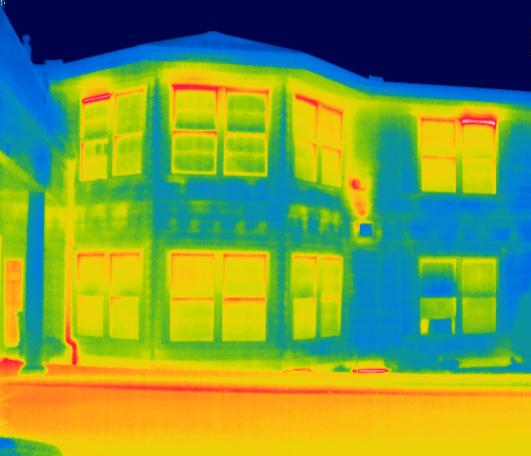Office Design
Design an Energy-Efficient Building Envelope
What Is It?

Infrared New England
The building envelope, the boundary between the interior and exterior of a building, performs a number of tasks including exterior protection (e.g. protection from the elements) and preservation of internal space requirements (e.g. thermal, light, and acoustic comfort, humidity conditions). The use of a range of building technologies to create an energy efficient building envelope reduces both the thermal energy lost to the building’s surroundings and the amount of energy needed to heat and cool the building. Heating, cooling, and ventilation are responsible for around a third of primary energy use in the commercial and residential sectors, and energy represents approximately 30% of the typical office building’s costs. The technologies deployed can address a number of sources of energy loss such as air leakage, wet insulation, and thermal bridging. Installation options include:
- Building insulation
- Fenestration (i.e. windows, doors, skylights)
- High efficiency glazing
- Air sealing
- Cool/green roofing
- Advanced building facades
The amount of energy saved depends on the building and the technologies used, though ENERGY STAR buildings have been shown to reduce operating costs for corporate real estate owners by up to $25,000 per year for every 10,000 square feet of office space. Insulation and air sealing through effective air barrier systems can reduce non-residential building electricity consumption by more than 25%. Building owners interested in making energy efficiency improvements to their buildings should conduct energy audits to determine the most cost-effective methods to improve the efficiency of the building envelope.
Benefits
- Significant reductions to building energy use for both heating and cooling
- In the event of blackouts, buildings can remain hospitable for greater periods of time
Drawbacks
- Significant upfront costs result in long payback for energy efficient technologies
- Highly insulated buildings carry higher risk of moisture-related damage
- Split incentive between tenant and property owner creates a significant barrier to major energy efficiency investment
Financing Options, Incentives, and Rebates
- Utility energy efficiency programs – Utilities such as National Grid and Eversource provide incentives and rebates for a wide range of energy efficiency technologies and upgrades for retrofits and new construction.
- MassSave – MassSave provides both incentives to commercial/industrial/institutional customers as well as interest-free loans of up to $500,000 for energy efficiency projects.
NEWS
- "CPD 4: Energy Efficient Building Envelopes"co.uk, September 2011
- "Maximizing the Building Envelope" Facility Executive, February 2017
RESOURCES
- FacilitiesNet: Building Envelope: How to Avoid Energy Loss
- International Energy Agency: Technology Roadmap - Energy efficient building envelopes
PROJECT EXAMPLES
- Atlantic Wharf, MA – Designed to use 42% less energy than comparable office buildings
- Castle Square Apartments, MA – Deep energy retrofit of a 1960s-era, 192 apartment building yielded a 72% reduction in energy usage at a cost of $42,593 per apartment


